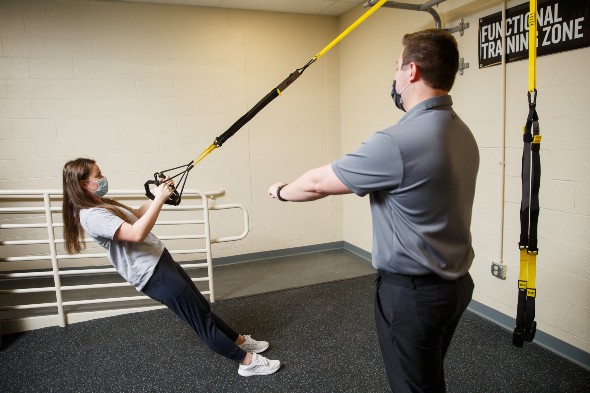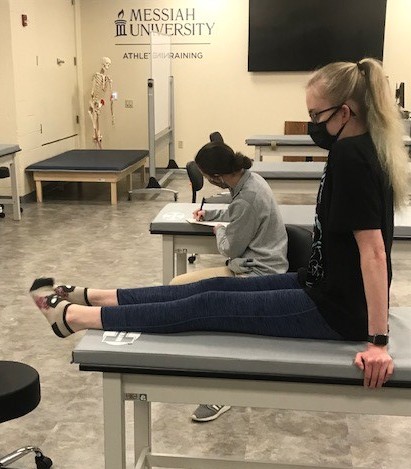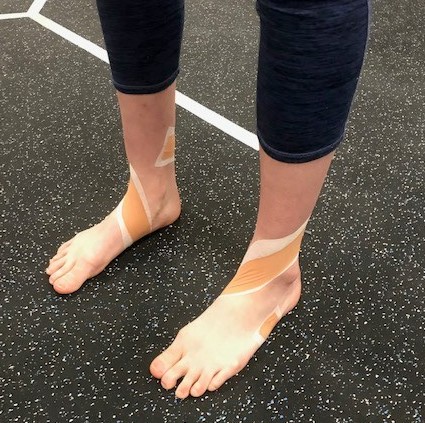Tuesday, March 30, 2021
Category: News
Athletic training program offers no-cost services to dance students

What do college students studying athletic training and dance have in common? One can rely on the other for furthering their experience and education. In the spring of 2019, Messiah University’s Athletic Training program proposed an idea: what if athletic training students had the opportunity to work with a new patient population? Offering a no-cost program to dance majors would allow Messiah’s athletic training students needing clinical experience to learn about the injuries and physical demands of dance, provide athletic training services, and gain clinical experience in a nontraditional setting.
While there are many opportunities for athletic trainers within the performing arts, most students do not have access to those athletes during their time at college. Plus, the opportunity for dance students to receive more consistent and personalized care makes this an opportunity that benefits both programs. “I think this collaboration between athletic trainers and dance majors is a win-win scenario,” said Gregg Hurley, associate professor of dance. “AT students get hands on experience with a different type of athlete and dancers get the type of care and attention that they require given the physical demands that they place on their bodies on a daily basis.”

Dancers, being dedicated to their craft, often continue to work through pain and discomfort without prompt access to athletic training services. This recent collaboration gives athletic training majors a chance to be embedded in Messiah’s dance program, working with the performing artists multiple times a week and allowing them to still participate while working through injuries. Now, athletic training and dance students have the chance to not only work through health and injury concerns from when they first occur, but also develop a better understanding of another program on campus and start new friendships.
“It’s great to see new relationships forming between these students that live on the same campus, but might not otherwise meet,” said Dr. Matt Lewis, associate professor of athletic training and athletic training program director. “Athletic training is a people profession. We exist professionally to help our patients overcome obstacles and achieve their goals. It has been fun to watch these two groups of students collaborate to confront and work to overcome obstacles together.”
State-of-the-art facilities
Previously located in a classroom with limited resources, athletic training students are now able to serve dancers two days per week in a new athletic training lab located in the lower floor of Eisenhower Campus Center. With more space, treatment tables and equipment, athletic training students offer dancers many services including therapeutic modalities, soft tissue mobilization, musculoskeletal rehabilitation and more.
“Not everyone has access to things they need to recover, but now we can walk down to Eisenhower and receive help for free,” explained Julia Mary Register ’22, a dance major. “I’ve appreciated the time Matt, Brenda, Amy, and all the other students have put into learning about dance so they can help heal the many injuries dancers face.” Going to the clinic helps dancers learn more about how their bodies work. Register added, “We are very familiar with how to move our bodies but not necessarily what muscles are being used.”
This updated space also offers more square footage, allowing for better social distancing safety measures during COVID-19, and open space for particular movements and exercise. Clinical staff will also help coordinate referrals to additional healthcare providers as needed.

While this idea was brought to life prior to the COVID-19 pandemic, the collaboration proved to be even more beneficial during a time when some clinical rotations were temporarily closed to Messiah’s athletic training students. “This pandemic has challenged us to be flexible with the many changes that we were faced with over this time,” said Amy Bruner, a senior athletic training major. “Being able to partner with the dance department has allowed me to stay engaged as a senior without the fear of not being able to leave campus due to COVID-19. It has been a different experience, and I am grateful for the opportunity.” Although the pandemic made in-person care a bit more complicated, students were able to help dancers while having guidelines in place to ensure safety while delivering quality care.
Click here for more information about the dance and athletic training programs at Messiah University.